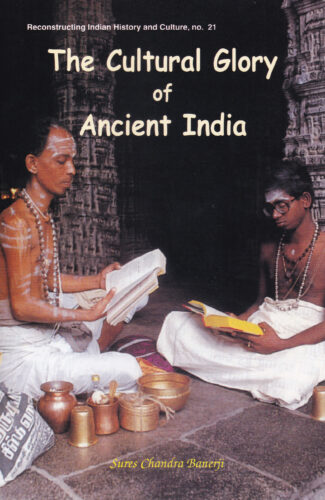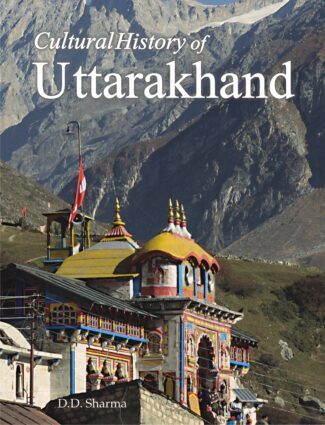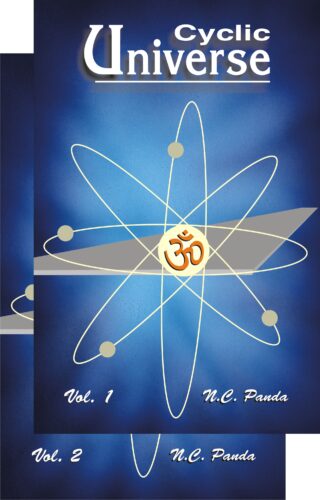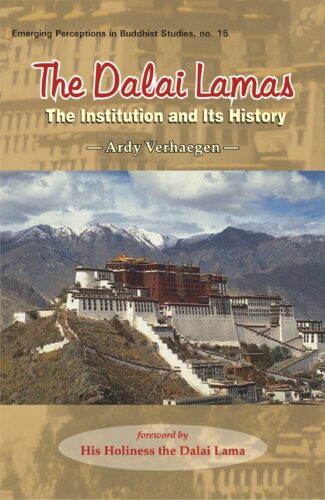Showing 181–190 of 1165 results

The book surveys the Vedic literature, epics, Puranas, classical Sanskrit poetry and prose and the vast Sastras to throw light on diverse facets from politics, religion and philosophy to agriculture, botany and architecture of ancient Indian culture.
India is a land of communities, and Kashmiri Pandits are one of them. Though they are the original inhabitants of the Kashmir valley famous the world over for its beauty and learning, they are living in their own country as refugees since 1989 due to religious persecution, ethnic cleansing and terrorism their only fault lay in their religion, Hinduism. This book describes basically the life and times of the half-a-million people of this community living in peace and harmony with nature. It also delves into the march of the people from medieval times into the modern age and the impact of transport and communication technologies that opened a window for information flow into the valley cocooned for so long due to the high mountains all around. Customs and traditions are described in a changing scenario brought about by the introduction of the English language in the late 19th century.

The book throws light on the socio-economic and cultural life of the people of Kinnaur in the trans-Himalayan region including a study of their customs and architectural heritage. It also deals with the universe under the various indigenous deities of cults like those of Vishnu, Shaiva and Shakti based on the Shu Republic in 15 deshang (villages) of Kinnaur.
The work is a study of the cultural heritage of the trans-Himalayan area of Himachal Pradesh, especially Kinnaur, that involves documentation of traditional institutions like temples, monasteries, Bon chos, artefacts, forts and old dialects of various ethnic groups.
Relying on field studies, the volume throws light on the socio-economic and cultural life of the people of the region of Kinnaur including a study of their customs and architectural heritage. It discusses the indigenous deities (Shu on rathang or Shu Republic) that rule and run the administration of the ethnic communities alongside the development administration and democratic set-up from the Panchayats upwards. It deals with the universe under the various indigenous deities of cults like those of Vishnu, Shaiva and Shakti based on an actual field study of the public proceedings of the Shu Republic in 15 deshang or villages of Kinnaur and the U-Khyang and Dhang-U-Khyang, i.e. the festival of flowers and the festival of the Dakhrain, in some deshang. With reference to the deshang, it provides more than a glimpse into their administrative set-up and customary laws and traditions, and describes various architectural designs of the native residential buildings. The book emphasizes the need for necessary conservation measures for the preservation of the cultural heritage of Kinnaur. It would be useful to scholars and students concerned with the study of cultural heritage of India.

This book gives a comprehensive account of the various aspects of the cultural history of the various tribes and races and the significant historical incidents that have taken place in their lives in the central Himalayan region, particularly in Uttrakhand.
Cultural History of Uttarakhand is an out-come of many years of keen observation of the linguistic and cultural phenomena of the whole Himalayan region, right from Ladakh in the west to Bhutan in the east and an intensive study of ancient Indian literature and of the historical incidents that have taken place in these Central Himalayan regions, particularly in the land termed as Uttarakhand. Though there are some works, both in Hindi and English, on the history and culture of this land, they pertain either to a specific region or to some particular aspect of it. This is for the first time that exhaustive chronological accounts of the history and culture of the inhabitants of Uttarakhand, including various ancient and modern tribes and races, right from Tons and Yamuna in the west to Mahakali/Sarada in the east, and from Bhotantic Himalayan regions in the north to Tarai-Bhabar area in the south, considered to be a `Cultural Area’ of Uttarakhand, have been taken into account for this study, in which an effort has been made to unfold various layers of the history of this land in a comprehensive way.
As such, this volume on the Cultural History of Uttarakhand is supposed to provide a rare opportunity to students, as well as to readers in general, to have an intimate knowledge of various aspects of the cultural history of various tribes and races inhabiting Uttarakhand from pre-historic periods to modern times.

This collection of scholarly papers focuses on the centrality of the Indian contribution in defining the Asian cultural matrix and brings under one rubric the views of Indian as well as Eurasian experts on the subject.
The reality of the Indian presence in Asian cultures is undeniable. Recent scholarship in the field of Asian cultural studies has laid much stress on the essential oneness of the substratum that defines what may be termed as an Asian identity. Buddhism and Hinduism, having originated in India, travelled beyond the frontiers of the land of their origin, and in many ways, moulded the beliefs and faith of the people of Asia. Trade, political ambitions, and religious pursuits led to a dissemination of Indian ideas and forms across Asia. In each area of Indian influence, the assimilation of Indian traditions with indigenous practices led to the development of a new idiom of expression with a distinctive localized identity. This collection of scholarly papers focuses on the centrality of the Indian contribution to Asian cultures and brings under one rubric, the views of experts from India, Nepal, Tibet, Sri Lanka, Afghanistan, Cambodia, Thailand, Indonesia, Mongolia, China, Korea, Japan, Belgium, Bulgaria, and the United Kingdom. Such an international representation, the consequence of a Seminar held in the National Museum Institute in collaboration with the Indian Council for Cultural Relations, New Delhi, is unique not only in providing the Indian point of view but also in revealing Eurasian perspectives on the subject of Indias pivotal role in defining the Asian cultural matrix.

The book explores various facets of Indian social and cultural thought and life that make the country an attractive tourist site: its people, history, arts, food and drink, customs and lifestyle. It includes a variety of discussions and data on tourism: tourism-related organisations and conventions, eco-tourism and Indias wildlife scenario, for instance.
The book is a detailed exploration of various facets of Indian thought and life that make it a popular cultural tourist site for visitors from all over the world. It presents an account of Indias people, history, national flag and national anthem, dance, drama, music, painting, textile, pottery, food and drink, and customs and lifestyle that comprise the multifaceted components of Indias culture. It describes all the major places of pilgrimage and festivals and scenic beauty in India, and lists state-wise a number of historical cities and sites that stud the length and breadth of the country, its attractive monuments steeped in history and its museums laden with treasures from the past. It brings out the special attractions in India for the western tourist who is primarily interested in those aspects of Indian culture that give a deeper meaning to life at physical, spiritual, mental and moral levels. The work offers, for students of tourism, data on various aspects to cover their syllabus: national and international tourist flow, tourism-related organisations and conventions, eco-tourism, Indias natural heritage as, for instance, its wildlife. It also gives an account of historical evolution of tourism in the world context. For professionals in tourism, there is information on organisation of package tours, tour circuits, tour planning, training of guides and marketing of tourism. Appendices discuss institutions where tourism is taught, tourist information centres in India and abroad, and tourism related periodicals.

The book explores various facets of Indian social and cultural thought and life that make the country an attractive tourist site: its people, history, arts, food and drink, customs and lifestyle. It includes a variety of discussions and data on tourism: tourism-related organisations and conventions, eco-tourism and Indias wildlife scenario, for instance.
The book is a detailed exploration of various facets of Indian thought and life that make it a popular cultural tourist site for visitors from all over the world. It presents an account of Indias people, history, national flag and national anthem, dance, drama, music, painting, textile, pottery, food and drink, and customs and lifestyle that comprise the multifaceted components of Indias culture. It describes all the major places of pilgrimage and festivals and scenic beauty in India, and lists state-wise a number of historical cities and sites that stud the length and breadth of the country, its attractive monuments steeped in history and its museums laden with treasures from the past. It brings out the special attractions in India for the western tourist who is primarily interested in those aspects of Indian culture that give a deeper meaning to life at physical, spiritual, mental and moral levels. The work offers, for students of tourism, data on various aspects to cover their syllabus: national and international tourist flow, tourism-related organisations and conventions, eco-tourism, Indias natural heritage as, for instance, its wildlife. It also gives an account of historical evolution of tourism in the world context. For professionals in tourism, there is information on organisation of package tours, tour circuits, tour planning, training of guides and marketing of tourism. Appendices discuss institutions where tourism is taught, tourist information centres in India and abroad, and tourism related periodicals.

The authors share their concerns for peace, situating their sensuous / intellectual / spiritual experiences in a culture of peace. They show how education, individual responsibility, philosophy, Gandhian non-violence, Buddhist compassion, etc. can reinforce the culture of peace.
Over the rolling centuries, peace has been a major concern: in religions and, more often, within socio-political contexts. Yet, perhaps ironically, the world history is a long, uninterrupted story of wars and violence. Not long ago in the aftermath of Hitlers defeat, the inception of the United Nations held out hopes of a new, free-from-war world order, which the hostile scenario today belies! Is peace then a dream? A Utopian abstraction in a dehumanized, fragmented world, stock-piling all-devastating war machines? And can we possibly uphold the culture of peace amidst the growing cult of violence and blind consumerism, or in a climate of distrust, acrimony and intolerance? Addressed in this collection of essays are these and other related questions by some of the best minds from different countries of Asia. Cutting across narrow compartmentalizations of disciplines, the authors try to share, with wider audiences, their concerns for peace, situating their sensuous/intellectual/spiritual experiences in a culture of peace. Also identifying specificities in terms of peace-threat-ening issues, situations, geographical zones, the volume attempts to show how education, individual responsibility, philosophy, ethics, artistic creativity, collective spirituality, Gandhian non-violence, Sufis universal love, and the Buddhist message of compassion and equanimity can reinforce the culture of peace even in the face of despair. This volume 6th in the Culture and Development series is essentially the assemblage of essays presented at the Asian Conference on The Culture of Peace: the Experiences and the Experiments, held on 25-29 November 1996 in New Delhi.

Professor Pandas insightful analyses corroborate the Vedantic world-view of the cyclic phenomenon of the origin, sustenance and dissolution of the universe, arguing that the universe has been created, it has a creator, and the expanding universe will contract by a reverse process to be finally dissolved in the power of Brahman.
Has the universe a beginning? Was it created? Who, then, is its creator? Or, alternately, is the universe uncreated? Is it beginningless and endless, with, of course, continual changes? Synthesizing the cumulative knowledge of science, philosophy, and religion: Eastern and Western, including Vedic/Vedàntic metaphysics, Professor Panda’s Cyclic Universe looks afresh at these mind boggling questions Þ which, ever since the dawn of human civilization, have evaded a convincing answer. In coming to grips with the issues around the evolution of the universe: the grand cosmos, the author examines not only the whole range of creation theories: both religious and philosophical, but also the Big Bang, its rival theories and modified versions, together with all the recent advances in anthropology, astrophysics, cosmology, Darwinism, molecular, biology, genetics, embryology, morphogenesis, neurobiology, and even computer science. Concludingly showing that the universe has been created, it has a creator, and the presently expanding universe will contract by a reverse process to be finally dissolved in the power of Brahman, Professor Panda’s insightful analyses corroborate the Vedàntic worldview of the cyclic phenomenon of the origin, sustenance and dissolution of the universe. Offering an original, well-integrated thesis on the baffling cosmic evolution, the book is bound to fascinate scholars and discerning readers alike.

Richly annotated, this work is a deep study of the institution of the Dalai Lama: its rise to prominence, its working and its role within the socio-political structures of Tibet and Asia. All this is set against a historical narrative that brings out the unique religious culture and spiritual legacy of the land.
From the fifteenth century on, the Dalai Lamas emerged as the pre-eminent spiritual and secular leaders of Tibet. In his foreword to this book Tenzin Gyatso the Fourteenth Dalai Lama states that Buddhism, with its powerful central message of compassion . . . transformed Tibetans from the powerful warlike nation that dominated Central Asia in the seventh century to the more peaceful and religious people they are today. With Chinas continued occupation of Tibet threatening the very existence of a distinct Tibetan identity and culture the Dalai Lama feels it his primary responsibility to take whatever steps I must to save my people and their unique heritage from total annihilation. Author Ardy Verhaegen not only succinctly tells the story of each of the Dalai Lamas and their contribution as human beings to Tibets destiny, as the Dalai Lama points out, but also the historical narrative within which these eminent personalities played out their lives. Starting with the spread of Buddhism and its introduction into Tibet, Verhaegen chronicles the development of that countrys unique religious culture, the rise to prominence of the Dalai Lamas, and the role of the Dalai Lama institution within the social-political structures of Tibet and Asia. Descriptions of the workings of the institution itself and the current struggles of Tibetan culture to survive outside its historical borders round out this volume. Richly annotated, this introduction to the institution of the Dalai Lama is of value to both serious students of Tibetan history and culture and all those interested in one of the more fascinating stories of our times. The perilous flight of the Dalai Lama into exile and the subsequent success of the Tibetan diaspora community against tremendous odds are having profound implications for humanity at large. Ironically, while imperiled within Tibet itself, the spiritual legacy of the land of snows has spread through its incarnate lamas and teachers such that the principles of peace, compassion and individual enlightenment inherent in Tibetan Buddhist culture and embodied in the Dalai Lama now enjoy favour worldwide. The awarding of the 1989 Nobel Peace Prize to the Dalai Lama is indicative of this esteem, not only towards His Holiness but also the institution he represents.

Darsanamala written in Sanskrit is one of the major works of Narayana Guru. Consisting of 100 verses divided into 10 chapters of 10 verses each, each chapter gives a different vision, complete in itself. The author here adopts the system of looking at non-dual, Ultimate Reality or Brahman from ten different points and a real seeker can intuitively perceive the non-dual Brahman within himself, he being inalienable from it.
Darsanamala written in Sanskrit is one of the major works of Narayana Guru. Consisting of 100 verses divided into 10 chapters of 10 verses each, each chapter gives a different vision, complete in itself. The author here adopts the system of looking at non-dual, Ultimate Reality or Brahman from ten different points and a real seeker can intuitively perceive the non-dual Brahman within himself, he being inalienable from it.
| There are no products |